Despite the sometimes unbearable summer heat and humidity in Florida, a shaded backyard can transform into a refreshing oasis where one can relax and cool off.
Help beat the heat by planting one of these trees that are sure to impress for their unique look and shading ability.
Hopefully, the advantages and disadvantages included for each tree will help you to make an educated decision on what will thrive in your space so you can enjoy it for years to come!
1. Live Oak
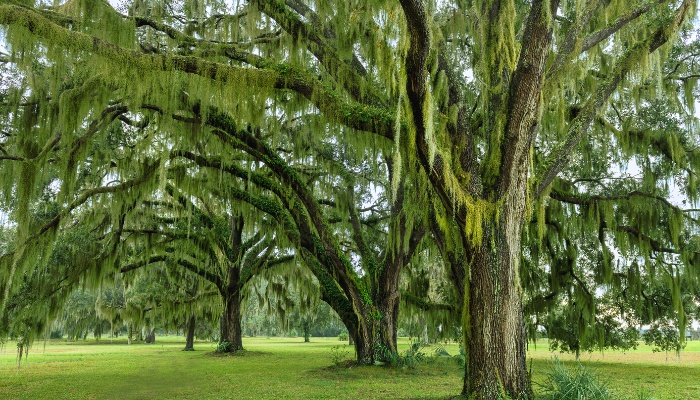
A mighty tree, the live oak is an evergreen variety with small oval-shaped leaves that have small teeth. It looks the same year round, flowering in the spring and producing slender acorns in late summer and fall.
Establishing with a great structure, this hardwood species is grand and will last a few lifetimes!
- Mature size: 40 to 80 feet tall and 60 to 100 feet wide
- Key advantages: Drought tolerant, heat tolerant, strong structure
- Potential drawbacks: Acorns, sharp leaves, large size
2. Red Maple

Leaves, leaves, leaves, of the brightest red you’ll see! Known for its vibrant red leaf color, the red maple is sure to impress for this reason alone.
A lush, dense canopy will provide shade in the summer, and the leaves will turn dark red and yellow in the fall before dropping from the tree.
- Mature size: 60 to 90 feet tall and 40 feet wide
- Key advantages: Dense canopy, unique appearance, fast growing
- Potential drawbacks: Samaras, heavy leaf drop, soft wood is susceptible to breaking
3. Florida Maple
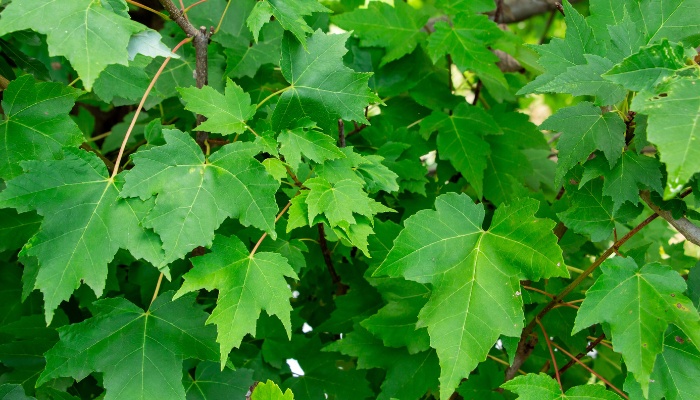
A native to Florida, this species is smaller in stature compared to most maples, so it fits well with most landscapes.
It has a green canopy during the spring and summer that transitions to red before dropping its leaves in the fall.
- Mature size: 20 to 30 feet tall and wide
- Key advantages: Heat tolerant, drought tolerant, tolerant of high moisture
- Potential drawbacks: Leaf drop, samaras, moderate susceptibility to pests
4. Weeping Willow
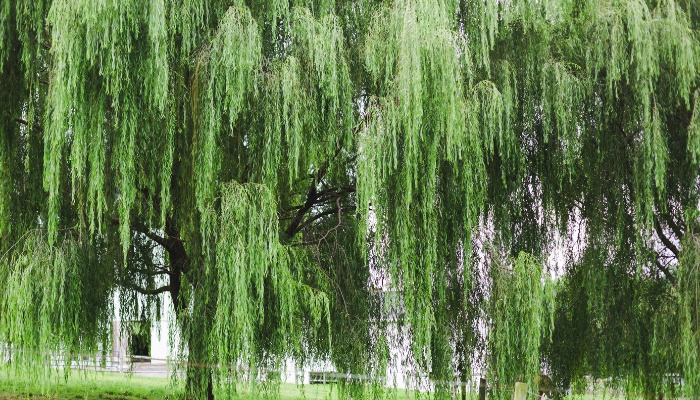
Everyone knows a weeping willow for its unique appearance, especially when flowering and its canopy is full of tiny yellow flowers.
With its long flowing branches and leaves, it produces ample shade, and its airy structure gives a great cooling effect to your yard!
- Mature size: 30 to 40 feet tall and wide
- Key advantages: Does well in wet areas, easy to grow, grows quickly
- Potential drawbacks: Strong invasive roots, messy leaf drop, shorter life span, potential diseases
5. Gumbo Limbo
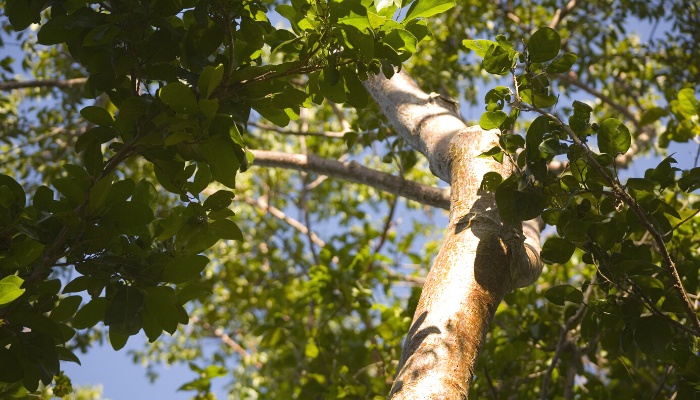
Standing out from the crowd with its bronze-colored bark that flakes off through the seasons, this deciduous tree will only drop its leaves right before growing a new set in the spring.
If you’re looking for a unique Florida native to plant, this is the species!
- Mature size: 30 to 40 feet tall up to 60 feet wide
- Key advantages: Native, unique appearance, wind tolerant, salt tolerant
- Potential drawbacks: Usually outgrows its space, only hardy in USDA Zones 10 and 11
6. Southern Magnolia
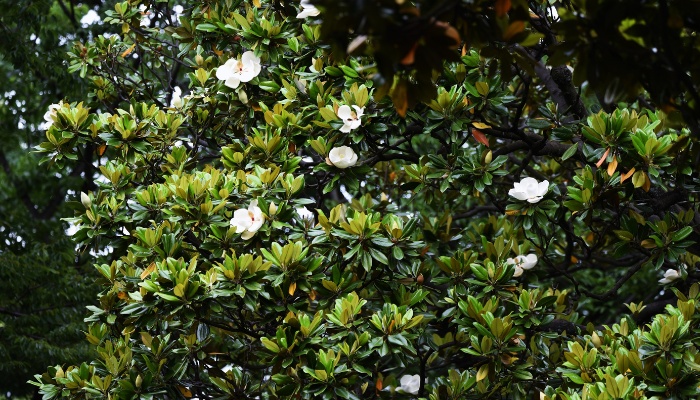
An evergreen variety that is a classic to Southern landscapes, the Southern magnolia has dark, shiny, green leaves on one side that are copper on the underside.
They bloom with fragrant massive white flowers and grow large seed pods in the early spring, sometimes continuing to bloom into the summer.
- Mature size: 60 to 80 feet tall and 20 to 30 feet wide
- Key advantages: Drought tolerant, heat tolerant, fragrant blooms
- Potential drawbacks: Messy seed pods, large growing, seed pods attract animals
7. Dogwood
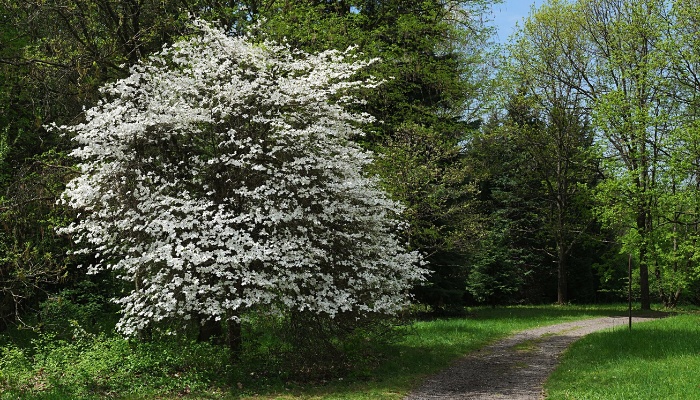
Magnificent white or light pink flowers cover this tree in the early spring with blooms lasting into summer.
In the fall, the leaves turn a dark red and drop leaving the silver bark exposed in the winter. Its smaller size makes it great for landscapes, and many planted together create a lovely backdrop.
- Mature size: 20 to 30 feet tall and 20 feet wide
- Key advantages: Easy to grow, ornamental value, abundant blooms
- Potential drawbacks: Susceptible to diseases and pests, odorous blooms, shorter lifespan, poisonous to dogs
8. Sweetgum
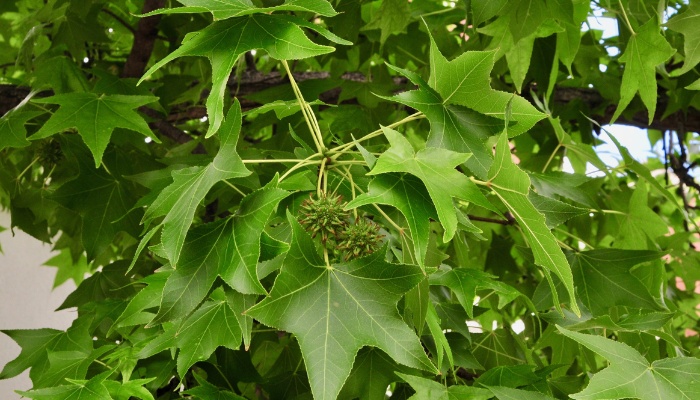
The sweetgum tree may fool you into thinking it’s a maple tree with its similar leaf shape, but its spikey fruit will make you think otherwise.
With green leaves in the spring and summer, the tree’s small flowers will produce spikey fruit balls dropping in fall once the leaves turn a vibrant red.
- Mature size: 60 to 75 feet tall and 40 to 50 feet at maturity
- Key advantages: Highly pest and disease tolerant, impressive leaf color in the fall
- Potential drawbacks: Messy with spikey fruit drop, hazardous fruit drop
9. Crape Myrtle
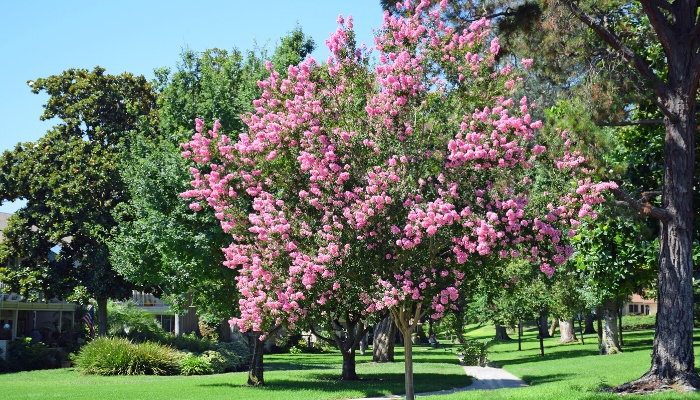
The crape myrtle is a smaller stature tree that blooms prolifically in the spring through the summer and even into fall.
Its pink, white, or purple blooms are lovely to see, and its bark adds texture to the landscape when the leaves drop in the late fall.
- Mature size: 15 to 25 feet tall and 6 to 15 feet wide
- Key advantages: Easy growing, long bloom window, hardy, drought tolerant
- Potential drawbacks: Grows lots of suckers, shedding bark can be messy, susceptible to pests and diseases
10. Crabapple
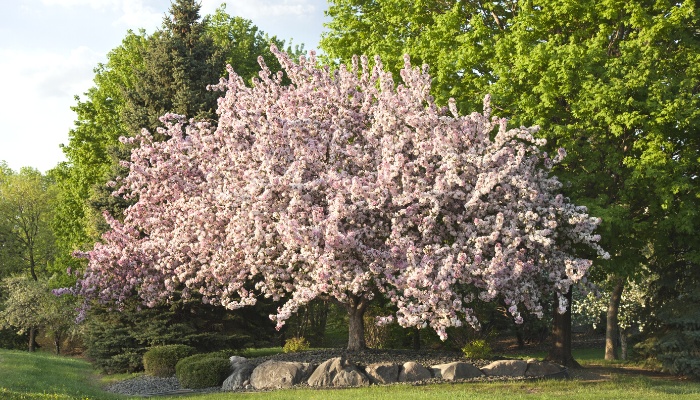
The crabapple is a lovely ornamental tree that bears countless white or pink flowers in the spring before its leaves grow. Covered in green leaves during the summer, this tree will produce many small apples that wildlife loves!
It is a compact tree that also attracts bees for its source of pollen early in the spring season while flowering.
- Mature size: 15 to 20 feet tall and wide. Dwarf varieties may only reach 5 to 10 feet tall and wide.
- Key advantages: Easy to grow, bountiful blooms, small size
- Potential drawbacks: Messy fruit and flower drop, can be odorous when blooming
11. Silver Buttonwood
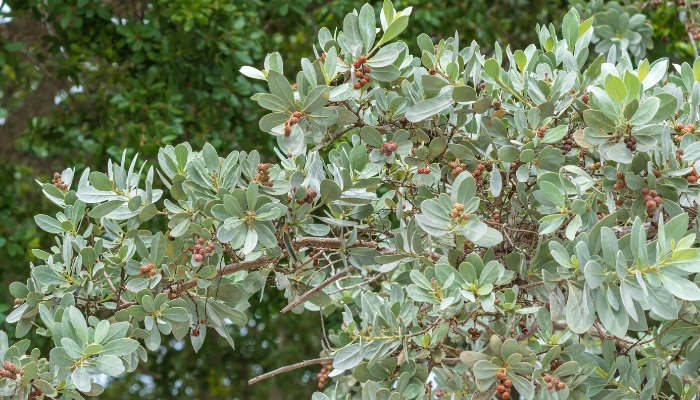
This Florida native is unique because it has silvery green leaves that grow in a whorled pattern. It is best used as a small ornamental tree for its evergreen habit and easy-growing low-maintenance life.
Try growing it as a single tree, or plant many in a row for a hardy privacy hedge in most weather variations.
- Mature size: 30 to 40 feet tall and 20 feet wide
- Key advantages: Highly tolerant of coastal climates, high salt tolerance, moisture tolerability
- Potential drawbacks: Poisonous to dogs, sensitive to cold
12. Pigeon Plum
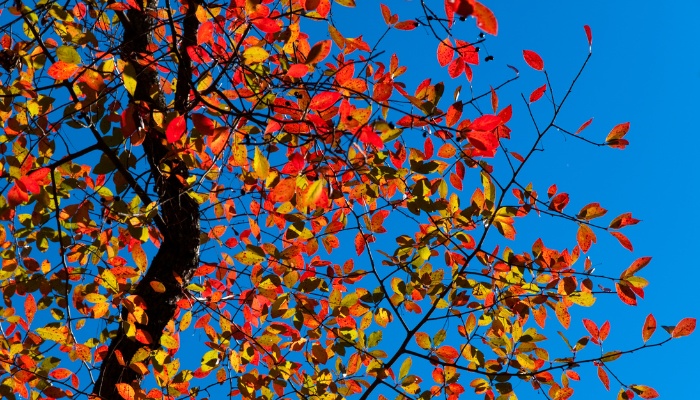
While its look may not impress with anything spectacular, edible fruits grow from the pigeon plum after it blooms in the spring.
Its flowers aren’t anything too showy, but it does have short racemes of white flowers that bloom for a short time in the spring.
- Mature size: 20 to 25 feet tall and 15 to 20 feet wide
- Key advantages: Edible fruit, compact size, salt and drought tolerant
- Potential drawbacks: Fruit will attract wildlife, fruit may stain the surrounding pavement
13. Black Calabash
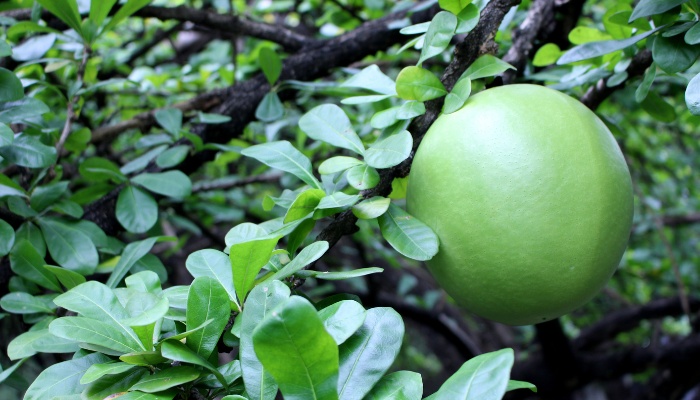
the black calabash is a curious tropical variety that grows edible fruit from its trunk and branches. It blooms with large purple tubular flowers periodically throughout the seasons.
The flowers may mature into large fruit that can be opened and has edible seeds. Its small but sprawling habit makes it great for adding shade to your backyard landscape.
- Mature size: 20 to 30 feet tall and 10 to 20 feet wide
- Key advantages: Edible fruit, evergreen
- Potential drawbacks: Only hardy in USDA Zones 10 and 11, fruit can become hazardous if not removed from the ground
14. Sycamore
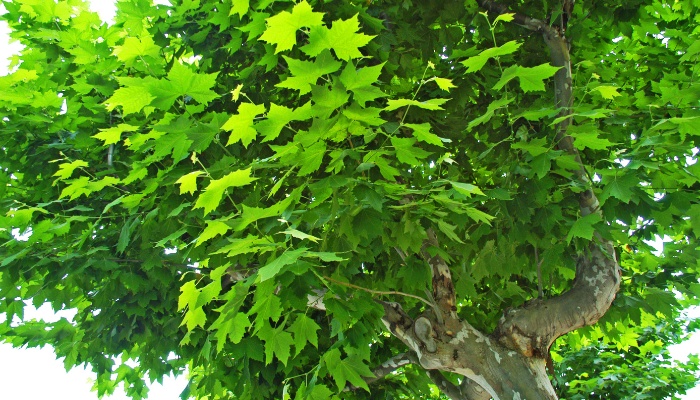
The sycamore tree’s large size makes it a great choice for shade! It has bark that stands out from the crowd with its peeling texture and bright white, gray, and tan color scheme.
Producing enormous-sized leaves that turn shades of orange, yellow, and red, this species also produces spikey fruit in the summer that drops along with the leaves in the fall.
- Mature size: 50 to 100 feet tall
- Key advantages: Unique bark, fast growing, easy growing, hardy
- Potential drawbacks: Messy with spikey fruit, large invasive roots, susceptible to bark insects
15. Paradise Tree
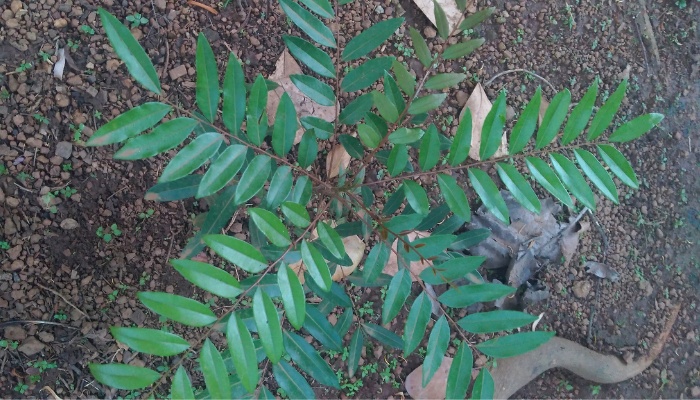
The paradise tree has interesting leaves with many leaflets that add a new texture to your landscape.
Yellow and white flowers are small and unnoteworthy, but the seeds are red, and new growth has a copper and red color that eventually turns to solid green once mature.
- Mature size: 40 to 50 feet tall and 20 to 30 feet wide
- Key advantages: Mostly evergreen in Florida climate, edible medicinal fruit
- Potential drawbacks: Messy fruit that may stain the surrounding area
Final Thoughts
The tropical climate of Florida allows countless species of plants to thrive with 15 of the best choices for shade listed above!
Use this list to help choose which varieties will grow best in your backyard to give shade and character to your landscape for years to come.
